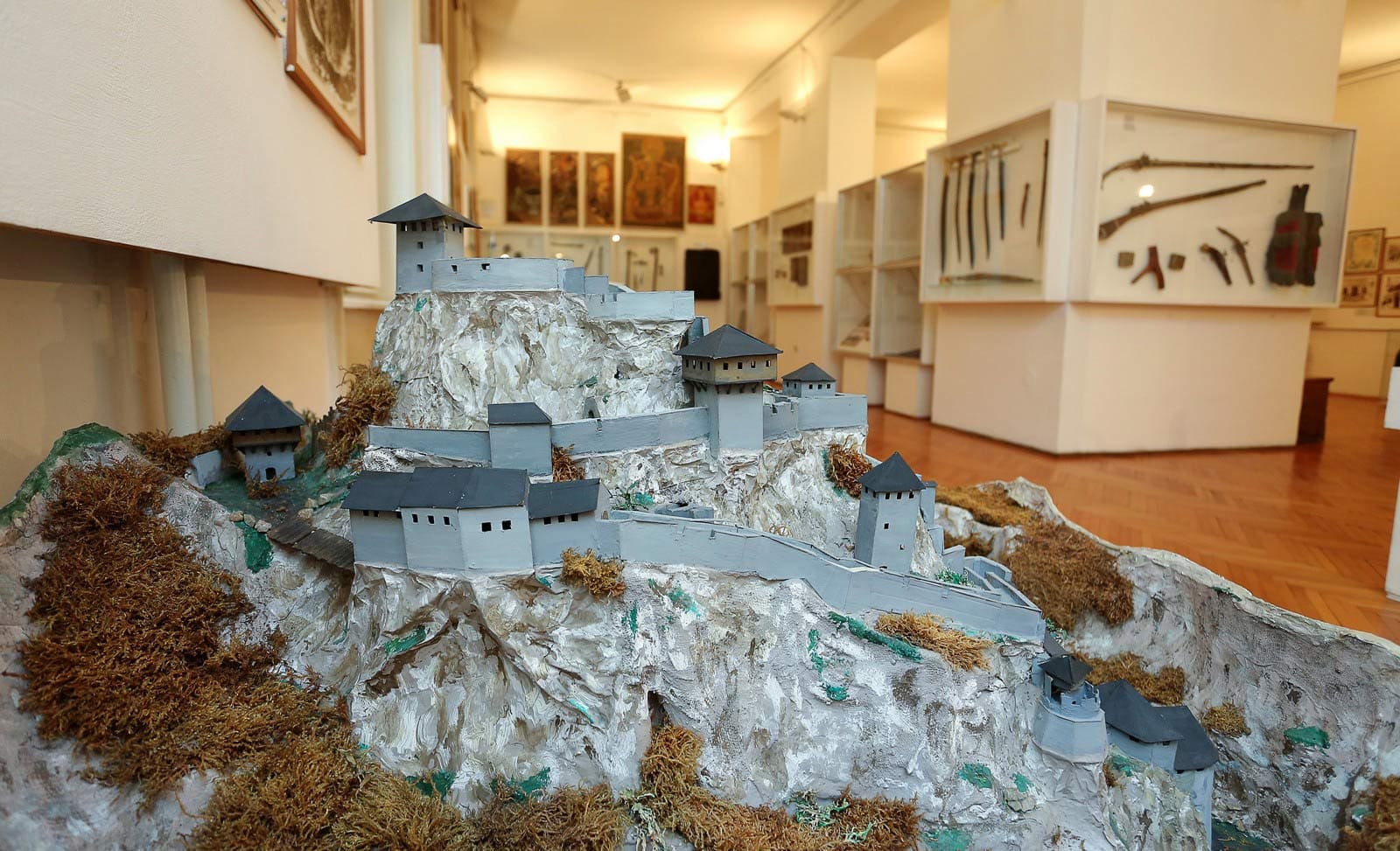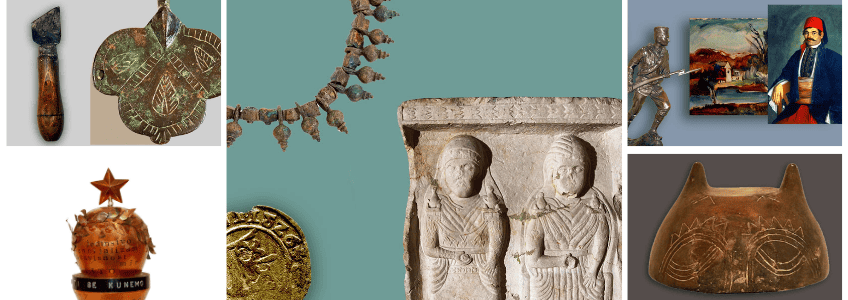About The MDiscover the National Museum Užice – Where History Comes Aliveuseum
The National Museum Užice (NMU) is a regional museum serving nine municipalities of the Zlatibor District and the city of Užice. Founded in 1946 as the Museum of Uprising 1941, it became the National Museum in 1963, uniting both the Museum of Uprising and the Local Museum. The Kadinjaca memorial complex, dedicated to historical events, is also under its care.
The museum houses professional departments in archaeology, ethnology, history, art history, conservation, and more, with experts dedicated to research, cataloguing, restoration, exhibitions, education, and publications. Its collections span archaeological, ethnological, historical, artistic, and numismatic objects, making NMU a hub for preserving cultural heritage.
NMU also protects immovable cultural heritage, including the Uvac Monastery and the log church in Sevojno, as well as memorial homes, fountains, and monuments dedicated to national heroes.
Visitors can explore permanent exhibitions across several sites:
- Uzice: Origin and Development
- Uzice Republic 1941
- Legacy of painter Mihailo Milovanović
- History of the Uzice Arms Factory (1928–present)
- Partisan Factory of Arms and Ammunition 1941 (in underground tunnels)
- The Town House from the late 19th and early 20th century (Jokanovića House)
- Workers Battalion in the fight on Kadinjaca and Uzice region in the NATO aggression (Kadinjaca memorial)
- Hydroelectric Power Plant “Under the Town” (since 2009)
The museum also includes the Local Museum in Nova Varoš.
For its dedication to cultural preservation, NMU has received prestigious awards, including the “Mihailo Valtrović” Award from the Museum Association of Serbia and the Vuk Stefanović Karadžić Prize.
Experience history, art, and culture at the National Museum Užice – a journey through time and heritage.
Uzice, Origin and Development
Permanent Exhibition opened in 1995 in the second building of the Museum, on the ground Hall, presents the origin and development of the Uzice region from prehistoric times, antiquity, middle, and the new ages, to contemporary history. More than 1,400 exhibits from all museum collections (archaeology, ethnology, history and art history) are exposed.
Explore the Departments of the National Museum Užice
The National Museum Užice (NMU) is home to a range of specialized departments, each dedicated to preserving, researching, and presenting the rich heritage of the Zlatibor District:
Archaeological Department
Excavating and protecting over 1,000 sites, this department preserves prehistoric, ancient, medieval, numismatic, and epigraphic collections.
Documentation Department
Established in the 1990s, it focuses on digitization, cataloguing, and integrating NMU into the Museum Information System of Serbia.
Ethnographic Department
Collecting material from the Tito Vužić region, the department showcases 19th and early 20th-century objects including:
- Costumes
- Home textiles
- Fiber processing equipment
- Musical instruments
- Pipes and smoking accessories
- Furniture and tableware
- Crafts and jewelry
History Department
NMU’s first department houses collections from the late 18th century to the 21st century, including:
- 3D objects
- Historical photographs
- Contemporary history
- Numismatics (15th–20th centuries)
- Archival and memoir materials
- Firearms, cold weapons, and military equipment
Conservation Department
Specialized workshops handle metal, wood, bone, glass, stone, ceramics, textiles, leather, and painting restoration, serving both NMU and external institutions.
Department for Preventive Protection and Maintenance of Monuments
Responsible for the Kadinjača Memorial Complex and other monuments, the department manages recording, preventive protection, and restoration projects, such as the log church in Sevojno.
Department of Art History
Houses the museum’s art collection, including:
- Fine and Applied Arts
- Ecclesiastical Art
- Sculptures
Pedagogical Service
Leads educational and cultural activities, including exhibitions, lectures, film screenings, and school programs, connecting the public with the region’s cultural heritage.
Pedagogical Service
Leads educational and cultural activities, including exhibitions, lectures, film screenings, and school programs, connecting the public with the region’s cultural heritage.
Professional Museum Library
A specialized library with 12,000 titles, including rare Serbian handwritten and printed books, Turkish manuscripts, and periodicals. It serves researchers, students, journalists, and the general public.
Photo Laboratory
Documents NMU collections, exhibitions, and local events, preserving thousands of photographs, films, negatives, and video recordings for research and public access.
This integrated structure allows NMU to protect, research, and share the cultural and historical legacy of Užice and the Zlatibor region with the world.
Uzice Republic 1941 – A Pioneering Liberated Territory
In late September 1941, the Uzice Republic was established as one of the first large liberated territories in occupied Europe, covering western Serbia, Sumadia, and the Morava river basin, with around one million inhabitants. The town of Uzice served as its center, initially occupied by Chetnik forces on September 21, and handed over to Partisan control on September 24.
During its brief existence, Uzice became the hub for the Supreme Headquarters of the National Liberation Partisan Troops, the Central Committee of the Communist Party of Yugoslavia, and the Central Committee of the League of Young Communists. Pre-war factories and craft workshops resumed production, while health services and railway transport operated for citizens. A vibrant cultural life flourished, with newspapers such as Vesti, Borba, Omladinska Borba, and Novosti circulating, and an art company with drama, music, and art workshops formed within the partisan unit on November 25, 1941.
The Republic’s defense culminated at Kadinjaca Hill on November 29, 1941, where the Workers Battalion, Partisan units from the Sava region, and Orasac troops resisted a much larger German force. Following the battle, the Supreme Headquarters, led by Josip Broz Tito, withdrew to Sandzak to reorganize and continue the resistance.
After 67 days, the Uzice Republic fell, and the rebellion in Serbia was suppressed. Despite its short existence, the Uzice Republic remains a symbol of early resistance and organized liberation during World War II.
The History of Arms Production in Uzice from 1928 to date
Permanent exhibition of the National Museum of Uzice, opened in 2006 year. This exhibition presents, to a lesser extent, conceptually amended exhibition of Commercial Museum Prvi Partizan, opened in the factory in 1990, and dismantled in 2002 (due to the collapse of SOUR Prvi Partizan). The current setting is only the history of arms production.
Memorial Complex Kadinjaca – Honoring the Heroes of the Workers Battalion
Located 14 km west of Užice, the Kadinjaca Memorial Complex honors the fighters of the Workers Battalion and Partisan units who fell defending the retreat of the Supreme Headquarters of the National Liberation Partisan Troops on November 29, 1941.
The original monument-pyramid, unveiled in 1952, houses the remains of many fallen heroes. Designed by Stevan Živanović, the 11-meter-high pyramid features a five-pointed star and engraved lines from the poem “Kadinjaca”. During the unveiling, Josip Broz Tito awarded the Workers Battalion the Medal of Merits for the People with a Golden Star.
From 1977 to 1979, the memorial was expanded into a complex by sculptor Miodrag Živković and architect Aleksandar Đokić, officially opened by Tito before over 100,000 citizens. The Workers Battalion was posthumously awarded the Medal of National Hero.
Today, the complex includes:
- Amphitheatre of the Užice Republic
- Avenue of the Workers Battalion
- Concourse of Liberty
- Commemorative Home with exhibitions on the Workers Battalion, Battle of Kadinjaca, and Užice region in the NATO aggression
- Visitor facilities, souvenir shop, and restaurant
Declared a historical landmark of great significance, Kadinjaca stands as a symbol of courage, sacrifice, and the anti-fascist struggle in Serbia.
Experience history, art, and culture at the National Museum Užice – a journey through time and heritage.
You can learn more about us here.




